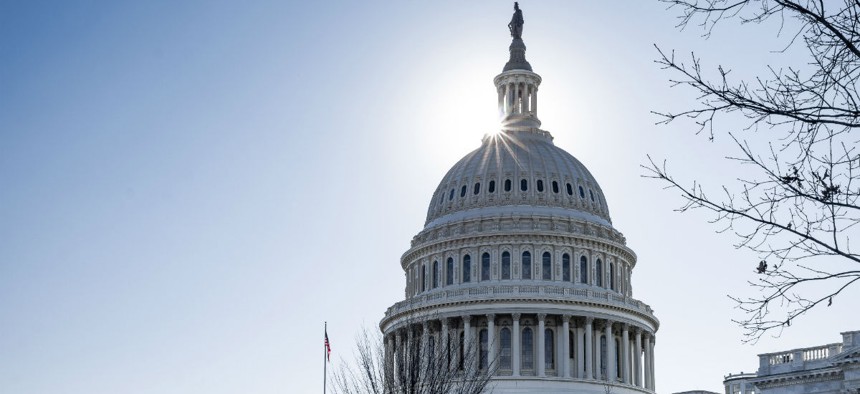
By anupap pokapanich / Shutterstock.com
Winners and Losers From the Fiscal 2019 Spending Deal
See what's in the bill to avoid another shutdown.
The federal government is likely to avoid another partial shutdown.
Lawmakers this week struck a bipartisan compromise to fund the agencies that have yet to receive full-year appropriations and the White House said President Trump would sign the measure on Friday. The bill largely rejects the dramatic cuts proposed in the president’s fiscal 2019 budget following a bipartisan deal in Congress that increased top-line spending levels.
Still, some agencies fared better than others, and lawmakers specifically rejected some of the administration’s top priorities. All federal employees were big winners in at least one respect, as Congress overrode an executive order from President Trump to freeze civilian pay. Here’s a look at the agencies and programs that will see some of the biggest changes under the new funding measure.
Winners
Homeland Security Department Hiring: DHS was the focus of much of the debate for funding the agencies that have yet to receive full-year appropriations, and the final agreement approved some new hiring. Customs and Border Protection will see its funding increase by nearly $1 billion over its fiscal 2018 funding level and receive $1.375 billion for new border barrier construction. Congress has provided it with funding for 600 new customs officers and encouraged it to hire 600 more using fees the agency collects. Immigration and Customs Enforcement will have funding for 155 new criminal investigations hires and 72 employees for opioids-based investigations. The agency will have $40 million for hiring staff to support “alternatives to detention” programs.
The National Treasury Employees Union said the CBP hiring will “start to relieve the stress of excessive overtime and temporary reassignments that are a strain on CBP employees and their families.”
FEMA: The Federal Emergency Management Agency, which just lost its Senate-confirmed administrator, will see its budget increase by more than one-third in fiscal 2019 to nearly $17 billion. Trump had recommended cutting funding for the agency.
Census: The Census Bureau will have an extra $1 billion as it prepares for next year’s decennial count.
Justice Department: Justice will see its budget jump by $638 million and $2.1 billion more than Trump suggested. The U.S. Attorney’s Office, U.S. Marshals Service, the FBI and the Drug Enforcement Agency will all experience significant funding boosts. The Executive Office of Immigration Review will receive funding for about 140 additional immigration judge teams.
Science: NASA will see its budget jump by $764 million compared to 2018, while the National Science Foundation will have an increase of more than $300 million. The National Oceanic and Atmospheric Administration will have $159 million to tackle climate change research, a 38 percent jump over Trump’s proposal.
State Department: The State and foreign operations budget will jump by $200 million to $54.2 billion. Trump had proposed slashing State’s budget by 22 percent. AIDS relief efforts will see a slight bump in funding despite Trump’s proposal to cut that spending by nearly $1 billion. Spending on international peacekeeping efforts will see a 12 percent jump.
Losers
Trump’s Proposed DHS Hiring: While many portions of DHS will have new money for hiring, those efforts will not be where the White House had proposed. Trump proposed funding 2,000 new ICE deportation officers and 1,300 staff to support them, but Congress did not provide any money for those hires. In fact, lawmakers said they cut $80 million from projected salary expenses “based on updated payroll analyses provided by ICE in January of 2019 indicating that payroll costs to sustain staffing levels achieved by the end of fiscal year 2018 would fall short of the amounts proposed in the budget request.”
Trump proposed funding for 750 new Border Patrol agents, but Congress froze the agency’s staffing at its current level.
USDA’s Reorganization: The Trump administration had proposed moving the Agriculture Department’s National Institute of Food and Agriculture out of Washington, D.C., and bringing the Economic Research Service directly under the purview of Secretary Sonny Perdue’s office. Lawmakers sought to hit the brakes on those moves, saying in explanatory text accompanying the spending bill they are “concerned about unknown costs” of the moves. They also demanded an “indefinite delay in the proposed transfer of ERS to the Office of the Chief Economist.”
General Services Administration: Congress authorized GSA to draw $9.3 billion from its Federal Building Fund, $847 million less than the agency requested. That could spell bad outcomes for federal employees’ workspaces: “Anything less means the agency will be unable to fund necessary repairs and improvements to the GSA inventory, which reduces the value of the public’s assets over time, results in unnecessary costs due to repairs, and missed opportunities to improve efficiency through the consolidations of space,” GSA said in its budget request.
Transportation Department’s Infrastructure Investments: Last year, the Better Utilizing Investments to Leverage Development (BUILD) grant program, which replaced the Transportation Investment Generating Economic Recovery (TIGER) program, received $1.5 billion to fund 91 projects in 49 states and Washington, D.C. This year, Congress allocated just $900 million for the program, a 40 percent decrease.







